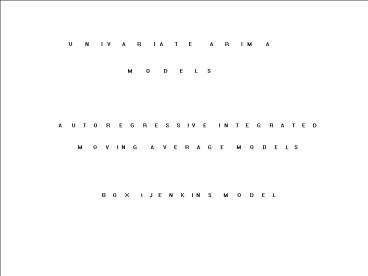UNIVARIATE ARIMA MODELS - PowerPoint PPT Presentation
1 / 21
Title:
UNIVARIATE ARIMA MODELS
Description:
Similar to a machine that takes the observed time series and turns them into ... Calculated Q-statistics is compared to chi-square value from tables. ... – PowerPoint PPT presentation
Number of Views:270
Avg rating:3.0/5.0
Title: UNIVARIATE ARIMA MODELS
1
UNIVARIATE ARIMA MODELS
- AUTOREGRESSIVE INTEGRATED MOVING AVERAGE MODELS
- BOX JENKINS MODEL
2
- A technique that tries to model the underlying
process (stochastic) of the time series - Forecasting by concentrating only on the past
patterns of the time series - Find a model that accurately represents the past
and future patterns of a time series
3
- Yt Pattern et
- The pattern can be random, seasonal, trend,
cyclical or a combination of patterns
4
- MODEL
- Similar to a machine that takes the observed
time series and turns them into forecasts and
white noise errors - Actual series ? Machine (Black Box)? Accurate
Forecast and White Noise residuals - AIM OF ARIMA DESIGN THE RIGHT MACHINE (IDENTIFY
THE RIGHT PATTERN)
5
- CONFIRMATION THAT CORRECT PATTERN HAS BEEN
IDENTIFIED REQUIRES WHITE NOISE RESIDUALS - Meaning
- ERRORS normally and independently distributed
(NID) - Errors have no pattern ? cannot be predicted
using past values - Errors have zero mean
6
- Steps in ARIMA modeling
- Model Identification
- Use graphs, statistics, ACF, PACF, etc. to
identify pattern and model components - 2. Parameter Estimation
- Determine model coefficients through software
applications
7
- Model Diagnostics
- Use graphs, statistics, ACF, PACF of residuals to
determine if the model is valid. - If valid, then use the model. If not, repeat 1,
2 and 3 again - 4. Forecast
8
- Breaking Down ARIMA
- Model 1
- AUTOREGRESSIVE MODEL AR(p)
- The time series is predicted using its own
previous values previous values - Yt ß1Yt-1 ß2Yt-2 ..ßpYt-p et
9
- AR(p) Autoregressive of order p
- i.e. using p past periods to forecast
- AR(1)
- Yt ß1Yt-1 et
- How do we determine p?
- Check ACF and PACF
10
- ACF should decline rapidly to insignificant
values (tend to decrease toward zero) - The number of statistically significant spikes in
PACF is your p (order of autoregression)
11
- MOVING AVERAGE MODEL MA(q)
- Model that predict time series based on past
forecast errors. - Yt et d1et-1 d 2Yt-2 .. dqYt-q et
- Similar to weighted average model
- q order of MA
12
- How do you determine q?
- If PACF gradually declines to zero, then the
number of significant spikes in ACF q
13
- AUTOREGRESSIVE MOVING AVERAGE MODELS ARMA(p,q)
- Predicting time series using past values of the
series and past values of the forecast errors - Mixed model
- Yt ß1Yt-1 ß2Yt-2 ..ßpYt-p d1et-1
- d2Yt-2 .. dqYt-q et
14
- To define an ARMA model, Check ACF and PACF
- Both ACF and PACF should gradually fall to Zero
- Count the number of AR and MA terms significantly
different from zero - For AR count PACF, for MA count ACF
15
- STATIONARITY
- Autocorrelations pattern dominate non-stationary
series. - So to determine the correct model and pattern,
wed have to stationarize the data - One of the ways to achieve stationarity is
differencing
16
- Sometimes wed have to find 2nd differences to
stationarize - Number of differences order of Integration d
- When we use differencing to achieve stationarity
the resulting model ARIMA(p,d,q) - Seasonal differencing ARIMA(p,d,q) (p,d,q)
17
DIAGNOSTIC CHECK OF MODEL
- To check if model is adequate (valid), check if
the errors generated by the model are white noise
by - 1. Create ACF for the residuals and check if
they have any significant spikes. If white
noise? no significant spikes
18
- Check the Ljung-Box Q-statistics.
- This is a chi-square test on the residuals with
m-p-q degrees of freedom - m number of time lags to be tested
- Calculated Q-statistics is compared to chi-square
value from tables. - If calculated Q is less than table value ? errors
are white noise
19
- If ACF plot of residual or Q-statistics shows
that the errors are not white noise ? model must
be redefined. - If two models yield white noise errors, pick one
with the lowest AIC or BIC - AIC Akaike Information Criterion
- BIC Bayesian Information Criterion
20
- AIC n ln(SSE) 2k
- K of parameters that are fitted in the model
- SSE sum of the squared errors
- n number of observations in series
- BIC n ln(SSE) k ln(n)
21
- You cannot compare the AIC or BIC of one series
with another series - You cannot compare AIC to BIC































